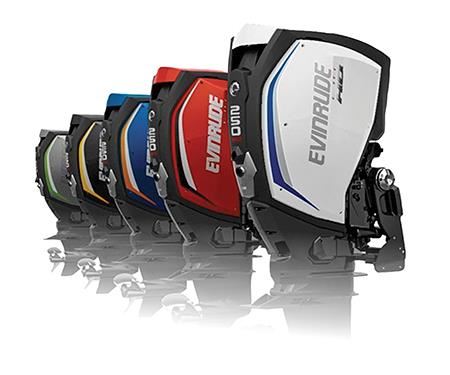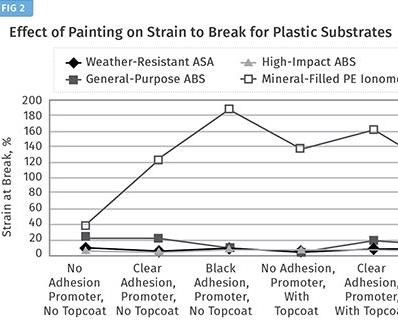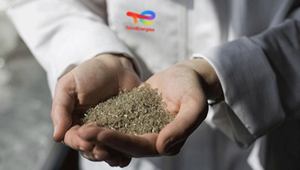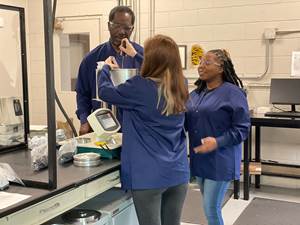Understanding the Effects of Paint On Plastics
Paint can have significant effects on mechanical properties of plastic parts. As illustrated by this OEM’s procedure in developing new-generation outboard-motor covers, there’s no substitute for thorough testing.
When you think about the testing required for painted plastic parts, what comes to mind? Color matching might be an obvious one; the paint needs to match the master color chip. This can be done using a spectrophotometer. Adhesion testing is another one; the paint needs to stick to the substrate. There are a number of test methods for this, including the peel test (ASTM D3359) and the pull-off test (ASTM D4541). You might also need to measure paint thickness or hardness. You might need to test some of the durability properties of the paint, such as abrasion or UV resistance.
But did you think about strain at break, or impact strength? These plastic properties can be affected by paint. If the paint is not properly matched to the plastic, it can severely degrade the mechanical properties. Testing is the best way to determine whether you have a good match.
Why paint plastics in the first place? After all, there are plenty of molded-in-color resins out there, and compounders are frequently coming up with new colors and effects. However, there are still many good reasons for painting plastics.
A term that is being used a lot in business these days is “mass customization.” This is the idea that mass-produced products can be tailored to the needs and desires of individual customers. For example, the customer could be able to select the color of the product from a broad palette, representing his or her unique personality. Producing such a wide variety of colors at an injection molding press would require frequent purging, which could be impractical, particularly if the number of parts required in each color is small. In this case, painting may be the best option.
Another reason to paint plastics might be to enhance the outdoor life of a part. Many polymers are attacked by the sun’s ultraviolet rays. While UV stabilizers can be added to the resin, paint can provide additional protection. Plastic parts may also be painted by customers or by aftermarket refinishers for customization or repair.
In all of these cases, it would be unacceptable for the paint to compromise the mechanical strength of the plastic. Customers may want to be able to choose products from among all the colors of the rainbow, but they don’t want products that will crack! Understanding the effects of paint on plastics is the key to achieving a good match.
HOW PAINT AFFECTS PLASTICS
BRP recently launched a new era in outboard engines with the Evinrude E-TEC G2. This revolutionary direct-injection, two-stroke motor (available from 200 hp to 300 hp) is more powerful, more fuel-efficient, and has lower total emissions than any other outboard in its class, including four-strokes. It also has a five-year corrosion warranty, the best in the industry. But what really has people talking is the fact that these engines are available in a wide variety of colors. In fact, boaters can visit chooseyouretec.com and select custom plastic motor covers to match their boat.
Some of the custom colors for the new Evinrude plastic motor covers have been achieved using molded-in-color resins, while others use paint. Since BRP is promising to set a new benchmark for durability in the outboard industry, it was absolutely necessary to ensure that the durability of the painted covers equals that of the molded-in-color covers. This meant that it was necessary to understand how the paint would affect the plastics used.
There are three ways that painting can affect the mechanical strength of plastics. First, paint solvents may attack the plastic. In fact, it is often desirable for the paint solvents to attack (etch) the plastic to a certain extent, since this improves adhesion. However, solvents can also cause surface crazing, or even environmental stress cracking. In addition, paint solvents may cause swelling, softening, or dissolution of the polymer. Once again, a certain amount of this may help to promote adhesion, but taken to an extreme, it can degrade the properties of the plastic to unacceptable levels.
Most plastics industry experts come from a chemistry background, so they tend to think that the chemical interactions between the paint and the plastic are the most important. While chemical effects definitely play a big role, there are two additional ways that painting can affect plastics—thermal and mechanical.
Many paints require curing at an elevated temperature. High temperatures can have a number of effects. First, they promote solvent diffusion into the plastic, potentially accelerating any solvent-related effects. Second, high temperatures may relieve molded-in stresses in the plastic part, potentially causing warpage. In addition, shrinkage of the paint during the cure process may produce residual stresses. Third, extreme high temperatures may cause thermal degradation of the polymer.
There are also mechanical effects: The strength and stiffness of the paint are different from those of the plastic, but they have to move together as a unit. Often, the paint is more brittle than the plastic substrate, which means that the paint will crack under loads that would not normally crack the plastic. Once started, a crack in the paint can do either of three things: The crack can continue through into the substrate; it can cause the paint to delaminate from the substrate; or it can “channel” through the paint without affecting the substrate. Which of these happens depends on the difference in stiffness between the paint and the plastic and the strength of the bond between the two.
PAINTING STUDY
(See original ANTEC paper for complete testing results.)
At the Society of Plastics Engineers’ ANTEC conference in Las Vegas earlier this year, I presented some results demonstrating the effect of painting on four different plastic substrates: general-purpose ABS, high-impact ABS, weather-resistant ASA, and 10% talc-filled nylon 6/polyethylene ionomer blend. This testing was part of the extensive research and development effort that went into the design of the new Evinrude E-TEC G2.
Two of these resins are typically painted (the two ABS grades), while the other two are typically molded-in-color. However, all four grades are paintable. Each of the resins has a similar mold shrinkage rate (around 0.005 to 0.007 in.), so any of them could potentially be used in the same tooling.
All four plastics were painted with a high-solids acrylic paint. Prior to painting, they were coated with either a clear adhesion promoter containing about 40% aromatic hydrocarbons or with a black adhesion promoter containing less than 2% aromatic hydrocarbons. The effects of the adhesion promoters by themselves (with no topcoat), and the topcoat by itself (with no adhesion promoter), were also tested.
Figure 1 shows the effect of painting on notched Izod impact strength. As you can see, for the nylon 6/ionomer blend, the impact strength actually went up by as much as 250% when painted. For this material, the adhesion promoters had a much larger effect than the paint itself; it’s possible that the solvents in the adhesion promoter softened the plastic, improving its impact strength. However, for the other plastics, painting reduced the impact strength by 20-50%. This behavior is probably more typical of plastics in general.
The test results also show how complex the interactions between paints and plastics can be. For example, neither the clear adhesion promoter nor the topcoat had a statistically significant effect on the impact strength of the ASA material when used alone. However, the combination of the clear adhesion promoter with the topcoat reduced the impact strength of the ASA by 40%.
Figure 2 shows the effect of painting on tensile strain (elongation) at break. Again, the nylon 6/ionomer blend behaved differently from the other materials. For that blend, painting increased the strain at break; for the other materials, painting reduced the strain at break. The effect of the topcoat on the general-purpose ABS was particularly notable. Unpainted, the general-purpose ABS had 22% strain at break. After painting with just the topcoat, the general-purpose ABS became very brittle, with just 5% strain at break. On the other hand, if the clear adhesion promoter was applied before the topcoat, the strain at break was 17.5%, not too different from the unpainted material.
The impact strength and the strain at break were the properties that were most strongly affected by painting. In some cases, painting slightly reduced the tensile modulus and/or the tensile strength, but not by more than 10%. The strain at yield was essentially unaffected. (Click here to download original ANTEC paper for complete testing results.)
A word of caution: these results only indicate the effect of this particular paint and these particular adhesion promoters on these particular plastics. Unless you’re using the exact same paint system on the exact same resin, you can probably expect different results.
Overall, however, these results show that the effects of painting on plastics are not straightforward and are difficult to predict. Using the wrong paint system can cause plastic parts to fail prematurely. On the other hand, picking the right paint system can help to ensure a world-class durable product, like the Evinrude E-TEC G2. Industry experts can help you find the right paint system, but as rocket scientist Wernher von Braun is reputed to have said, “One good test is worth a thousand expert opinions.” If you want to make sure you have the best match, make sure to test.
Related Content
S&B Selected as Contractor for New Hope Energy Advanced Plastics Recycling Unit
New Hope Energy and Total Energies collaboration for an advanced plastics recycling unit gains momentum.
Read MoreNOVA’s BOPE-HD Film Resin Gains in Globally Available Flexible Food Packaging Applications
Positioned as a recyclable packaging alternative to traditional BOPET films, BOPE-HD film is now available from companies such as Inteplast, JK Materials, Oben Group, and Polivouga.
Read MoreSD Polymers: 'One-Stop Solution for Mechanical Recycling'
‘Passionate’ recycler invests in people and technology to meet commitment to innovative, sustainable solutions for its processor customers.
Read MoreAutomation in Thermoforming on the Rise
Equipment suppliers’ latest innovations exemplify this trend driven by factors such as labor shortages, higher-speed thermoformers and tighter quality control.
Read MoreRead Next
How Polymer Melts in Single-Screw Extruders
Understanding how polymer melts in a single-screw extruder could help you optimize your screw design to eliminate defect-causing solid polymer fragments.
Read MoreAdvanced Recycling: Beyond Pyrolysis
Consumer-product brand owners increasingly see advanced chemical recycling as a necessary complement to mechanical recycling if they are to meet ambitious goals for a circular economy in the next decade. Dozens of technology providers are developing new technologies to overcome the limitations of existing pyrolysis methods and to commercialize various alternative approaches to chemical recycling of plastics.
Read More
















.png;maxWidth=300;quality=90)













